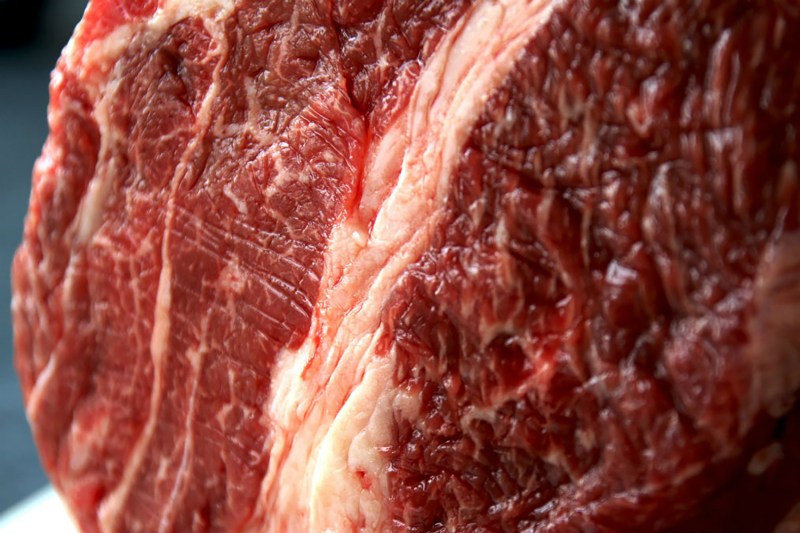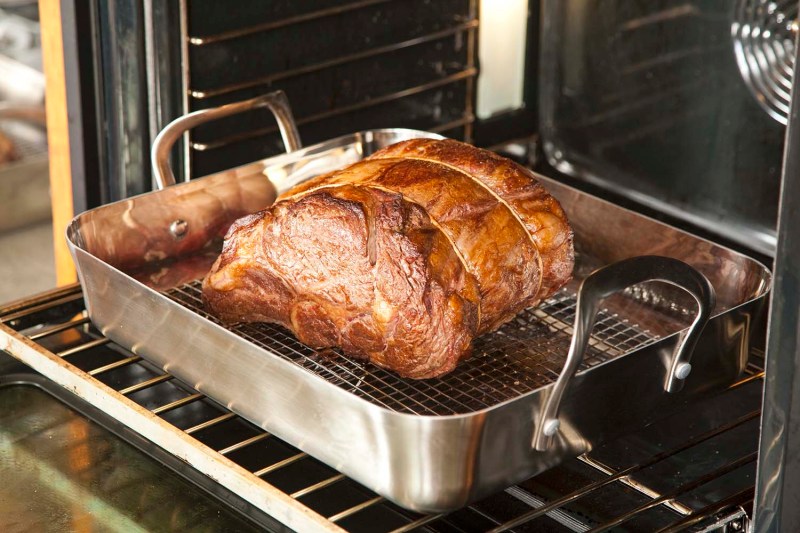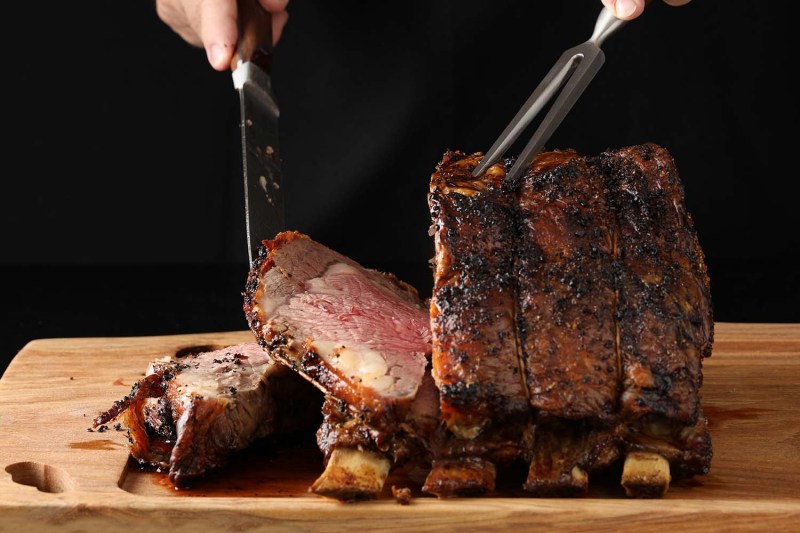How to Cook Beef Rib Roast Bone in Using Convection
If you like eating normal cuts of beef, then you like eating prime rib. It's just how the cookie crumbles (how the steak grills?). Prime rib, which is perhaps the most classic when it comes to classic cuts of beef, is a nice, hearty slice from the primal rib section of the cow. It features the typical "eye" of rib (with or without the actual bone) and is ensconced in perfectly marbled muscle. Sounds delicious, right? It is. It can also be expensive, which is why more often than not people save prime ribs for special occasions, such as anniversaries or holidays.
What is prime rib? A thick slice from the primal rib section of the cow and features your typical "eye" of rib (with or without the actual bone) surrounded by deliciously marbled muscle.
However, prime rib, aka standing rib roast, is different than other meats like your standard steak or a rack of ribs — instead of throwing it on the grill, you bake it as a roast for a couple of hours. Sounds simple, right? In a sense, it is, but there are a few things you should know before you slap on your favorite apron and fix it up for the first time.
To better understand how to cook prime rib, we tapped the culinary wisdom of Beau Carr, executive chef at RingSide Steakhouse in Portland, Oregon. Carr has more than 30 years of experience in the restaurant industry and has served as the chef at this Portland institution since 1998.
How to Select a Prime Rib
"You want to start out with the best quality product before you go to the cooking process," says Carr. "Number one: You want to specify the grade." If you already know something about meat, then you know that the United States Department of Agriculture (or USDA) has three levels of quality: Prime, Choice, and Select. Prime is the best, Choice is great, and Select is … pretty good.

Prime rib doesn't have to be USDA Prime; in fact, Carr doesn't recommend going Prime for your rib roast, as the marbling (fat content) may be too much. On the other side of the spectrum is Select, which doesn't have nearly enough flavorful marbling. Carr says Choice is just right — it's what Goldilocks orders at her favorite steakhouse. Most grocery stores carry Select rib roasts, premium grocery stores have USDA Choice, and specialty butchers should have Prime.
For the sake of simplicity, Carr recommends a boneless, lip-on roast rather than a bone-in 109 roast. In case you don't know, "109" is the IMPS/NAMP designation for a tasty cut of prime rib. "The thing about a bone-in rib roast is your portioning is going to be determined by the spacing of the bone, which means you're going to have giant slices," says Carr. If you're okay with giant slices, go ahead and go for the bone-in 109 roast. Some say the bone is great for flavor and moisture.
How to Prepare Prime Rib
Be sure to get the age of your roast from your butcher. This is important because you want a minimum of 28 days of wet age before you cook your roast. "Wet age is when the product is in the original vacuum-sealed bag from the meat processor," says Carr.
You want a minimum of 28 days of wet age before you cook your roast. Salting and dry-aging are optional but add more flavor.
After 28 days have elapsed, you might move onto a dry-aging process. "If you have the refrigerator space, you can do what we do," says Beau. "You can season your roast, put it in your refrigerator on a baking pan with a wire rack, and leave it there for three days." Salting and dry-aging your prime rib (as you can see below) is completely optional, but if you have the time, you'll find that it adds more flavor to the final product.
Lesser prime rib guides might tell you to tie your rib roast with twine. Carr has something to say on the matter: "We don't tie our prime rib roast because it's not really necessary and it's kind of messy and inconvenient." Chuck roast and round roast are a different story — these cuts need twine, as they're comprised of different muscles that would otherwise separate and distort during the cooking process. If your butcher gives you a pre-tied roast, however, there's no need to remove the twine.
How to Cook Prime Rib
After you've successfully endured the aging period, it's showtime. Let your roast warm up to room temperature, then turn on the oven. "I would go for a high-heat attack at first to caramelize the outside of the prime rib — probably about 450 [degrees Fahrenheit]," says Carr. "If you have a convection oven, you might want to turn the heat down by 25-50 degrees." Once the oven is heated, put your roast into the oven and bake for about 20 minutes.

After the high-heat attack, open the oven door to let the excess heat out and lower the oven heat to about 250 degrees Fahrenheit. From that point, it'll take about 1.5 to 2 hours for a 12- to 14-pound roast to reach an internal temperature of 110 to 115 degrees, which is ideal for a mostly medium-rare roast.
It'll take about 1.5 to 2 hours for a 12- to 14-pound roast to reach an internal temperature of 110 to 115 degrees Fahrenheit.
"You can't uncook something," Carr points out. "You want to start checking your internal temperature after about an hour." You must stick a high-quality probe thermometer into the thickest part of the roast and keep a close eye on the temperature. Since all ovens and roasts are different, there's no standard cooking time. As Carr says, "Cook it until it's done."
Cooking the roast to 115 degrees Fahrenheit on the inside will yield a few rare slices in the middle, mostly medium-rare slices, and a few medium slices on the outside — this should accommodate most refined steak eaters. If anyone wants their slice more done, you can always cook the roast for a few more minutes. However, Carr offers a solemn warning: "If you cook a roast to 135 or 140, then pull it out of the oven, it's toast."
How to Carve Prime Rib
Once the prime rib has done its time in the oven, you must resist the urge to start slicing right away, even if your guests are growing unruly (give them some great craft beer while they wait). You need to let the roast rest for about 20 minutes so the carryover cooking can take place.

"You want the juices to redistribute and for all the temperatures to equalize throughout the roast," says Carr. "Then, when you slice it, you're going to have a minimal loss of juiciness." Carryover cooking should increase the internal temperature to the 130-140 degree Fahrenheit range.
After you let the roast rest, then you can give in to the lamentations of your hungry guests and start carving. Carr is partial to inch-thick cuts, but really it's a matter of personal preference. Some people enjoy super-thin English-style cuts of prime rib.
Side Dishes for Prime Rib
Yorkshire pudding and au jus are classic accompaniments to prime rib. Fresh-ground horseradish or horseradish cream sauce is quite nice, too. You can't go wrong with mashed potatoes or a baked potato for the starch, and asparagus or baked spinach for the vegetable.
As for wine, you'll want a "big" Cabernet or Merlot to keep up with the flavors of your prime rib. However, Carr stresses the importance of drinking whatever appeals to you. "A good wine is one that you like," he says.
Prime rib occupies a hallowed space in the minds of meat lovers. Still, you shouldn't let that deter you from attempting it yourself. Learning how to cook prime rib can revolutionize your dinner parties, family dinners, or dinners alone (we don't know your life).
Once you've mastered a prime rib roast, it's time to try your hand at some of these other meaty skills:
- How to Cook Ribs in the Oven
- How to Cook Steak in the Oven
- How to Grill the Perfect Steak
- How to Smoke Meat
- How to Butch a Crown Roast
Article originally published by TJ Carter on September 13, 2016. Last updated by Sam Slaughter on October 23, 2019.
Editors' Recommendations
- How to Cook With International Blends, Pastes, and Rubs
- Chipotle's Metaverse Burrito Builder: Is It Worth the Time?
- Best Omaha Steak Deals: Get a Filet Bundle for Just $80
- What Are Chicken Oysters and Where Are They Located?
- Need to Elevate Your Pasta Dishes? Learn How To Make Pesto
Source: https://www.themanual.com/food-and-drink/how-to-cook-prime-rib/
0 Response to "How to Cook Beef Rib Roast Bone in Using Convection"
Post a Comment